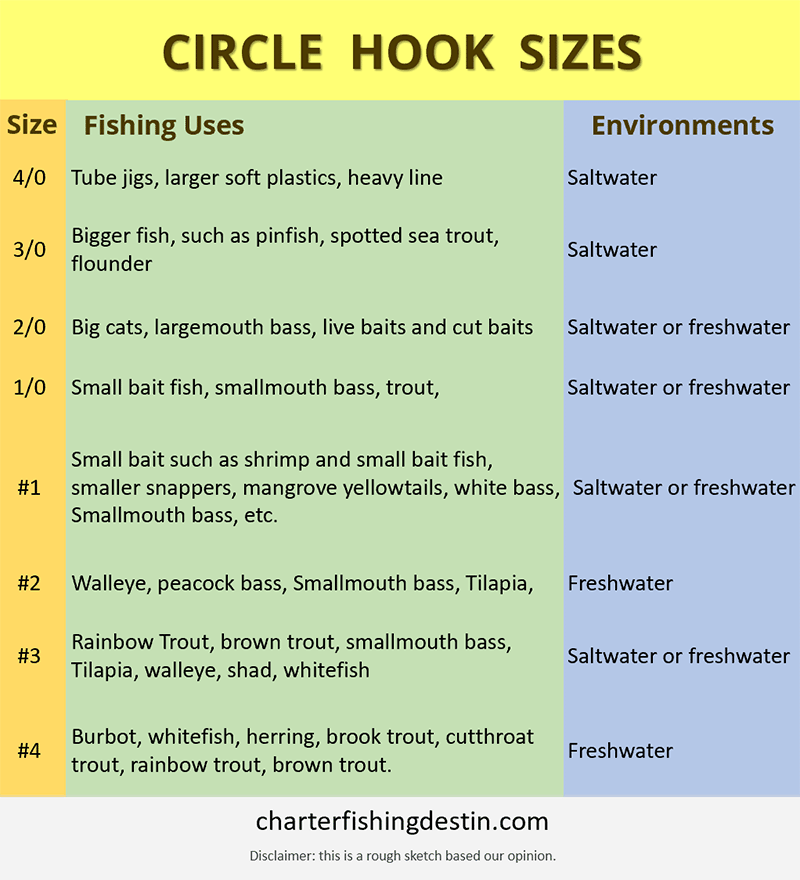What is the best circle hook for your fishing adventure? The truth is that while size matters, it varies depending on the fish you want to target. We will sort that out later in this blog, and we encourage you to take a closer look at the circle hook size chart here and explore the various circle hook sizes.

Circle Hook Sizes
You may have noticed that circle hooks run in two ways – the # or the /0- For example, the #1 circle hook is different from the 1/0 circle hook. As you choose your range of circle hooks understand that with the # number system on hooks, the larger the number the smaller the hook. So, a #4 hook is smaller than a #1 hook. With the ought or aught system, the hook sizes are followed by a /0 – for example, 1/0 is a one aught hook, and it is smaller than a 4/0 (four aught) hook.
Another key consideration when choosing the hook size regardless of the style of hook circle, J, etc. – is that you need to match the hook to your bait size, and bait size is a reflection of the fish you want to target. Many fish, with some exceptions, will eat whatever food will fit in their mouth. By matching the size of bait to the mouth size of the fish you want to target, you can sometimes eliminate pesty bait steelers that will take your bait even though they are small.
There are physiological reasons for choosing the right hook. With circle hooks, you want to pay attention to the gap. That is the space between the point of the hook and the shank. Wider gaps allow thicker jaws to enter the circle of the hook and therefore allow you to hook bigger fish. Smaller gaps make it more difficult to hook bigger fish since the hook will not fit over their jaws.
How to Choose the Right Size Circle Hook for Your Goals
Fishing hooks have seven parts. These include the:
- Eye – where you tie your line to the hook
- Shank – Attaches to the eye and is a straight part that ends where the hook begins to bend.
- The Bend – The bottom of the hook where the metal forms a U-shape
- Throat – where the hook begins to straighten after the bends – there is often a barb in the throat to help keep the hook in place.
- The Point – where the throat meets the barb
- The Barb – the sharp part of the hook that penetrates the fish’s flesh to help set the hook and keep it in place.
- The gap – The span of air – no metal – between the barb or point and the shank. The gap is the diameter of the opening that indicates the fish jaw size to hook size ratio.
Choosing the best circle hook is all about two things.
- The diameter of the metal that makes up the hook – thinner for smaller fish, bigger for heavier baits, and for bigger fish.
- The gap measurement so that you can gauge what size fish will fit the hook or what size bait you can use with this hook.
The exact size of the circle hook will vary from one species of fish to the next. For that reason, you want to think about what size bait you will use or soft plastic. Longer soft plastics, which are very popular, take bigger hooks. You want the shank of the hook to be longer so that the head of the soft plastic piece sits at the eye of the hook and the bend emerges from the soft plastic near the middle or top third of the soft plastic mimic.
You also want to think about the gap, especially with circle hooks. The gap needs to be large enough so that the hook will be set above the jawbone. If it does not, the fish can tear – literally – away from the hook.
Best Circle Hooks for Saltwater Fishing
Two brands stand out when you shop for circle hooks. Mustad and Gamakatsu.
Gamakatsu Hook Selection with Size Charts
There are other brands of circle hooks that are also awesome. Eagle is one such brand.
For saltwater fishing, you will likely stay with a 2/0 hook for most inshore and some offshore fishing. For reds and speckled trout, you can do down to a 1/0 or stay with the 2/0
#4-6 for Jack Mackerel, if you are targeting bigger fish such as Cobia, or Yellowtail 5/0 is a good bet. If you are using soft plastics as bait, consider a 3/0 or larger depending on the length of your soft plastic bait.
For massive fish, such as marlin, you will head to the top of the big hooks with 10/0 and 11/0 hooks. You could use a 10/0 or 11/0 circle hook for the red snapper. Their mouth is huge, and they don’t typically shy away from hooks.
What size circle hook is right for your next fishing adventure? If you are going solo, stick with a selection of circle hooks to match the catch available. A good quality 2/0 will do you well for most inshore fishing. 3/0, 4/0, and 5/0 for medium-sized fish and go big – 10/0, 11.0 for anything with plenty of weight and a big mouth.
